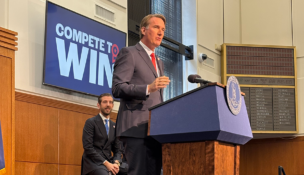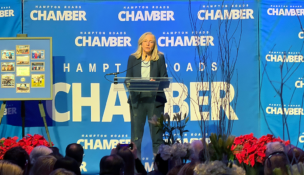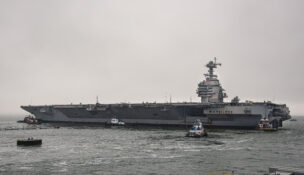A diversified portfolio
Beach officials seek to expand city’s economic base
Carl Fincke //April 28, 2022//
A diversified portfolio
Beach officials seek to expand city’s economic base
Carl Fincke //April 28, 2022//
In a city where tourism reigns, nothing could be more welcome than a post-pandemic world. And though we’re not quite there yet, Virginia Beach is licking its chops over the prospect of maskless visitors pouring into town.
The city, with fingers crossed in hopes that new coronavirus variants don’t arrive before the tourists do, is preparing for a summer like no other. In fact, last year was no slouch — even with COVID-19 still haunting travelers.
“It’s important to note that tourism was as strong in Virginia Beach as it could be during the pandemic,” says Taylor Adams, Virginia Beach’s deputy city manager and director of economic development. “Last year set records for hotel revenue, we think largely from pent-up demand from the two previous seasons. We anticipate this will be another strong season. We’re especially excited about the return of international tourism, particularly from Canada.”
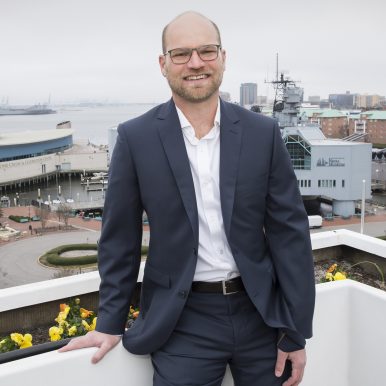
Tourism is considered a top driver in the Virginia Beach economy, employing more than 15,000 people with an impact of $1.42 billion in 2020, the latest figures available from the Virginia Tourism Corp. (See related story.) While city officials acknowledge that military spending might have a greater economic impact — they say it’s difficult to nail down exact figures — it’s a relative rock with little fluctuation. But tourism can grow or shrink due to a variety of factors: weather, gas prices, even a disruptive virus.
The best investment portfolio is diversified, though, and Virginia Beach officials have been working to balance the city’s economy. While tourism and defense are clearly the city’s two blue chips, its No. 3 industry might be a surprise: the quiet workhorse of agriculture ($134 million).
“I’m not sure who started referring to the three-legged stool in Virginia Beach, but I have great pride that in the most populous city in Virginia, agriculture is one of those legs that holds the city up,” says Roy D. Flanagan III, Virginia Cooperative Extension’s agriculture and natural resources extension agent for Virginia Beach.
With roughly 450,000 residents, Virginia Beach has — by far — the most residents of any city in the state. Its 23,000 acres of agriculture, largely grouped in the city’s southern area, have traditionally been devoted mostly to grain — corn, wheat and soybeans. There’s also considerable horse territory in the city, as well as hog production.
“Agriculture is really a part of the culture of the city,” says Adams. “We believe traditional uses will continue to be strong, but we’re really excited about the expansion of hydroponic farming, vertical farming, into Virginia Beach. And we’re finding that we’re becoming a destination as well for the life sciences and for biological engineering.”
By wind and by sea
The city’s bid for economic diversification includes wooing renewable energy and high-tech businesses.
The $9.8 billion Coastal Virginia Offshore Wind project calls for Dominion Energy Inc. to construct 176 turbines 27 miles off the city’s coast. Scheduled to begin operating in 2026, it’s projected to be the largest offshore wind farm in the United States, generating enough renewable energy to power 660,000 homes.
The project received a boost in October 2021 when Siemens Gamesa Renewable Energy S.A., a Spanish wind turbine company, committed $200 million for an offshore-wind blade factory at a marine terminal in neighboring Portsmouth. That facility aims to produce blades for 100 turbines a year — including the 176 for Dominion’s offshore wind farm. The giant turbines are more than 800 feet tall — considerably taller than the 555-foot-tall Washington Monument.
“Siemens Gamesa, that was the big domino to fall, one of the world’s most preeminent offshore wind companies selecting Hampton Roads,” says Matt Smith, director of offshore wind business development for the Hampton Roads Alliance, the regional economic development organization. “We’re trying to attract companies that can make investments and employ Virginia workers so we can become one of the hubs of the industry.”

The wind farm will require a specialized workforce. Many of those skills are already found among the region’s shipyard workers, but to ramp up the number of qualified workers, the state has created wind-power training programs at several institutions, including the Centura College location in Virginia Beach, and the city is investing $1 million in a similar program at Tidewater Community College.
Smith says the massive offshore wind farm’s job impact will be considerable: around 900 workers for the construction phase, then 1,100 for the farm’s operation and maintenance. Plans call for adding more wind farms in the area, he adds, and analysts project these could create between 5,000 and 6,000 additional jobs.
Virginia Beach’s push to become an East Coast tech hub also includes a mushrooming subsea cable operation in the city’s southeast corner. Three of the world’s fastest data transmission cables land at Telxius’ 25,000-square-foot campus in the Corporate Landing Business Park.
The data cables connect Virginia Beach to Spain, Brazil, Puerto Rico and France. City officials are hoping that as many as 15 more cables will eventually join the party. Canada-based PointOne Development Corp. is building a 40,000-square-foot data center in the business park. Construction on the network access point was paused during the pandemic, but Colin Clish, chief operating officer for PointOne, says it will resume this summer.
Small footprints, big impact
At 249 square miles, Virginia Beach is the state’s third-largest city in geographic size, behind only Suffolk and Chesapeake. A tiny fraction of that real estate — just 77 acres, or less than 1/10th of a square mile — could have an oversized impact on the city’s future.
Three well-known strategic parcels have been in the spotlight for years. All three finally could be on the verge of being reborn: Pembroke Mall, the Dome site and Rudee Loop.
When it opened in 1966, Pembroke was the first shopping center of its kind in the Hampton Roads region — an enclosed mall with more than 20 stores. Since then, it has ridden the typical mall roller coaster of revolving anchors, facelifts and reinventions.
Situated on a 54-acre plot near the city’s geographic center, across Virginia Beach Boulevard from the bustling Town Center complex, Pembroke Mall is destined for a major transformation. Its owner, the Virginia Beach-based Pembroke Realty Group, has proposed a $200 million makeover of the mall into a mixed-use property.
“Malls in general should be renovated every eight to 10 years,” says Pembroke Realty Group President Ramsay Smith. “I did the one here in 2003. When I got here in 2001, it had red brick floors — red brick!”
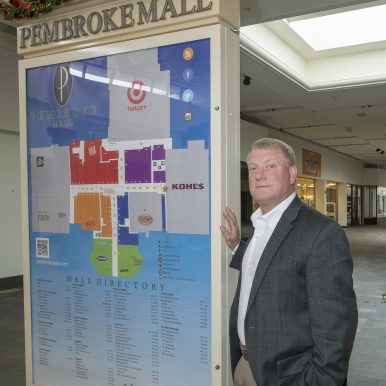
The mall’s new mixed-use plans call for a blend of residential and commercial development. New construction would include a 153-unit senior living facility, a 324-unit apartment building, a 14-story hotel and a public parking garage. The center of the current mall would be demolished but two anchor stores, Kohl’s and Target, would remain, along with several other existing retailers.
The mall redevelopment project’s first phase would be the senior living rental community, with groundbreaking planned for July and the project scheduled for completion by early 2024. The seven-story building will feature 121 independent living units, but also have some assisted living and memory units.
Next will come the apartment building and hotel, with construction to start in early 2023 and both scheduled to open for business around the end of 2024. Smith says a later phase is also planned: a pair of 18- and 22-story office buildings.
Rudee awakening
For decades, one of Virginia Beach’s most challenging tasks has been what to do with the Dome site. Built in 1958, the former concert venue hosted legendary performers such as the Rolling Stones and Jimi Hendrix before its 1994 demolition. For the past three decades, it has been a parking lot and the subject of countless development proposals.
The latest idea could be the one that finally brings life back to the 10-acre site a block off the Oceanfront between 18th and 20th streets. Grammy-winning music icon and Virginia Beach native Pharrell Williams is partnering with Virginia Beach-based Venture Realty Group on a $325 million public-private partnership to build Atlantic Park, an entertainment and surf park complex, on the site. The centerpiece of the plan is a surf pool that would generate 1,000 waves an hour. The proposal also includes a 3,500-seat concert hall, apartments and retail space.
Virginia Beach has repeatedly bought additional parcels for the project and has seen its stake in the deal rise. Originally approved by City Council in 2021, the project was supposed to break ground during the first quarter of 2022, but supply chain issues and rising construction costs interfered. City Council agreed late last year to extend the developers’ deadline for finalizing financing to June 1.
Mike Culpepper, a managing partner with Venture Realty, says the company won’t comment on the project. Nevertheless, Adams, with city economic development, says a deal is close: “We’re staring at the finish line.”
Another undeveloped 11-acre parcel a few blocks south of the proposed Atlantic Park site is also attractive — and more up in the air. Rudee Loop sits on the southern tip of the Virginia Beach Oceanfront that ends at Rudee Inlet, separating the tourism strand from residential Croatan Beach.
A prime piece of real estate, Rudee Loop has been in flux for almost two decades, ever since the city purchased the once-legendary Lighthouse Restaurant that overlooked the Atlantic Ocean. Before that, the city had been buying up pieces of Rudee Loop for years, with initial intentions for the property to be developed commercially.
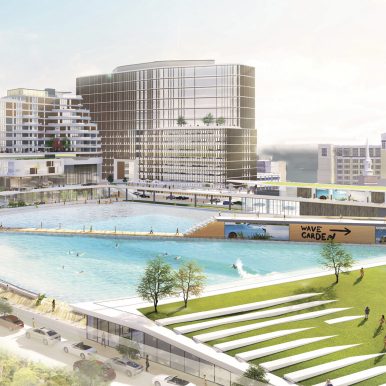
A variety of proposals have been floated for the spot, including two from NFL Hall of Famer Bruce Smith, a Norfolk native who was also a star football player for Virginia Tech. The city has held numerous public forums, and its latest plan in 2019, which called for a mix of open space and commercial development, caused such a furor that a “Save Rudee Loop” movement was formed.
A contentious battle ensued over what to do with the property: Should it be for commercial use or dedicated as green space? Public sentiment quickly shifted against private development. An online poll came out strongly against a hotel, restaurants or the like. Instead, the poll showed support for recreational amenities such as a skate park and public art.
The city is hoping to decide soon which way to go. Adams declined to say much about the status of the project but adds that he’s trying to gauge what interest there might be in the market for developing the site.
On the other end of the spectrum, Virginia Beach is trying to awaken the potential of a sleeping giant: Naval Air Station Oceana. The sprawling air base sits on nearly 7,000 acres, and while it’s already a strong driver of the economy, it also taunts developers with its empty fields buffering the airstrips.
The Virginia Beach Development Authority has begun working with the Navy on exploring partnership opportunities. Adams says that in March, the two sides agreed to their first work order for a specific, though undisclosed, plot of land.
“We think that some of these parcels are of appropriate size and location for industrial and distribution uses,” Adams says.
In April, the development authority and NAS Oceana took another step forward by hosting Future Base Design Industry Day, in which the two groups gave presentations focused on development possibilities for Oceana’s former horse stables, a 113-acre plot less than a mile from the Oceanfront.
>



